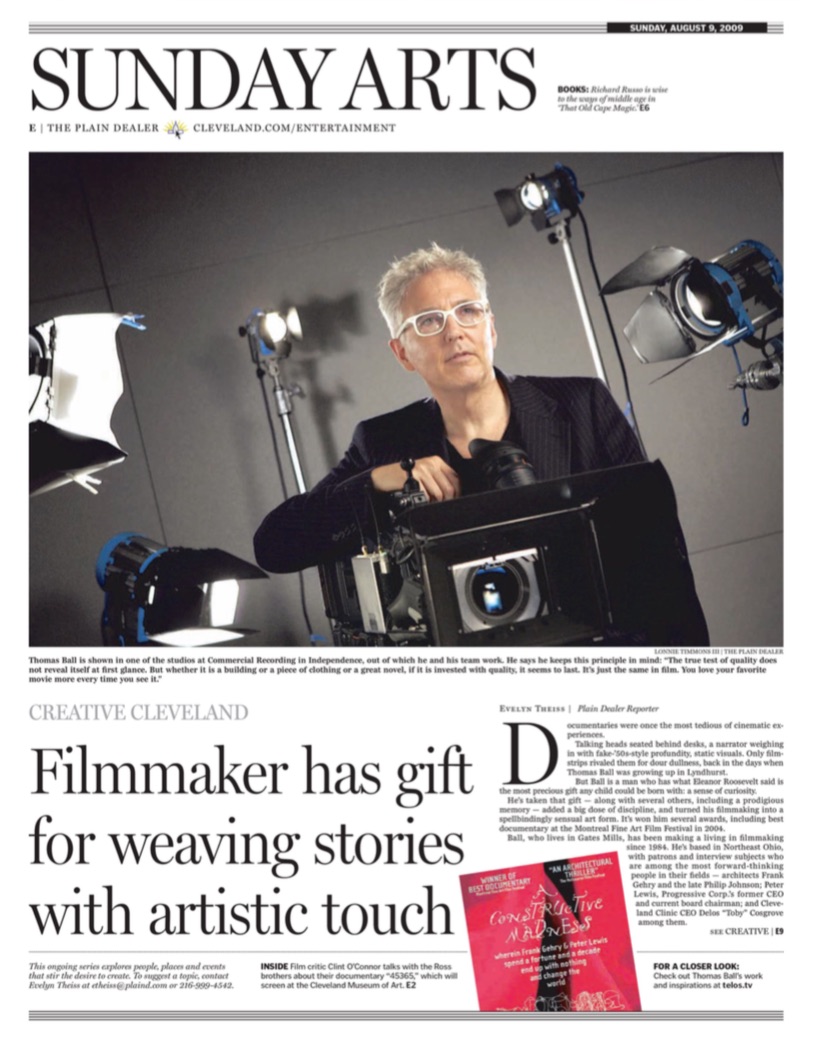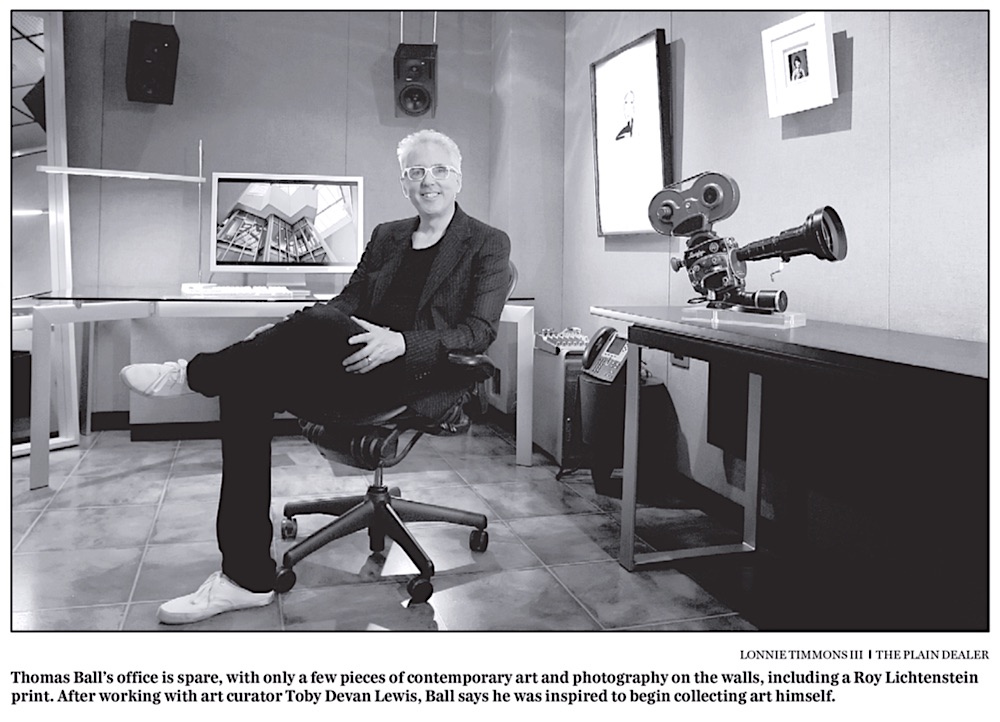Telos featured in Cleveland Plain Dealer
August 9, 2009
The Cleveland Plain Dealer Sunday Arts Profile
Update November 2016: Although Tom Ball is now living in Boston’s Financial District, this 2009 article from the Cleveland Plain Dealer provides a well-written overview of his career and projects.
by Evelyn Thiess. Photo by Lonnie Timmons.
Documentaries were once the most tedious of cinematic experiences. Talking heads seated behind desks, a narrator weighing in with fake-’50s-style profundity, static visuals. Only filmstrips rivaled them for dour dullness, back in the days when Thomas Ball was growing up in Lyndhurst.
But Ball is a man who has what Eleanor Roosevelt said is the most precious gift any child could be born with: a sense of curiosity.
He’s taken that gift — along with several others, including a prodigious memory — added a big dose of discipline, and turned his filmmaking into a spellbindingly sensual art form. It’s won him several awards, including best documentary at the Montreal Fine Art Film Festival in 2004.
Ball, who lives in Gates Mills, has been making a living in filmmaking since 1984. He’s based in Northeast Ohio, with patrons and interview subjects who are among the most forward-thinking people in their fields — architects Frank Gehry and Philip Johnson; Peter Lewis, Progressive Corp.’s former CEO and current board chairman; and Cleveland Clinic CEO Delos “Toby” Cosgrove among them.
Ball may work for heavyweights, but he conveys an unaffected nature. At 57, with a fast, boyish walk that seems to require the white sneakers he wears, Ball waxes with excitement telling any of a hundred tales he could about how he got a certain shot or picked a particular piece of music for the score.
His white-framed glasses — made by a boutique designer in Venice — hint at his quirkiness but not his efficiently punctual nature.
Henry Adams, an art historian and professor at Case Western Reserve University, has collaborated with only two documentary filmmakers: Tom Ball and Ken Burns, who, along with Michael Moore, is probably the most widely known maker of documentaries.
Adams contributed to a film Burns did on the painter Thomas Hart Benton, then was an interview subject and writer for a documentary Ball made on Cleveland artist Christopher Pekoc, “The Beauty of Damage.”
“I’ve been very lucky to work with both of them,” says Adams. “What separates both from other documentary makers is that they are not only visually gifted, but smart in all the other ways you need to be. They know how to put a story together.”
A personal film odyssey Tom Ball’s interest in film was piqued when he took a film course as a student at Brush High School in the late 1960s — and even more so when he saw Stanley Kubrick’s “2001: A Space Odyssey” in 1968. Seventeen times.
What especially stuck with him was the importance of using music to bring a depth of mood to what was happening on the screen, something that still sets his work apart.
Ball decided to study film at New York University, but left after a year, mainly because of his dismay when he saw the quality of films by that year’s graduating class.
By then, yoga had cast its spell on him — he met his wife, Catherine, through his practice — and he’d shifted his major to India studies. Film, he decided, was something he would do on his own, by apprenticing to others who worked in the medium.
By the early 1970s, after getting his degree in India studies from the College of Wooster and studying Hinduism, he was on his way to India to make a short film from a tale of Indian folklore, called “Vishnu’s Maya.” It was an allegory about the dangers of forgetting your true purpose.
He still has the camera he used, a Beaulieu R16. It sits on his desk today, at his office inside the studios of Commercial Recording in Independence, alongside a 32-inch flat computer screen he uses for work. The technology of making a film has changed radically in the three decades since his days in India — from expensive film to less-costly high-definition digital video — but the importance of telling a compelling story hasn’t.
In January 1977, Ball appeared on the cover of The Plain Dealer Sunday Magazine, the month that “Vishnu’s Maya” premiered at the Cleveland Museum of Art. A photo shows the gangly filmmaker, then 24, standing in water up to his knees, shooting from a camera on a tripod.
Since then, he’s made films on all kinds of topics, for all kinds of clients, in more comfortable venues. Paris, say.
Minute details and big pictures
One of his favorite collaborators was Stanley Garfinkel.
Ball was visiting Paris in 1986, and he read about a documentary on Christian Dior in a French publication. He noted that the film was written and produced by Stanley Garfinkel, history professor at Kent State University.
The filmmaker was intrigued, so when he returned to Cleveland, he called Garfinkel. The two met, and Garfinkel asked if he wanted to work with him on a documentary on the French shoe designer Roger Vivier, who had created made-to-measure shoes for Dior.
Ball did — he’d always had an interest in fashion.
The two men produced the work in association with the fashion museum of the Louvre. Among the people Ball and Garfinkel interviewed were Vivier himself, the well-known socialite and couture collector Nan Kempner, jewelry designer Kenneth Jay Lane, and some of the best-known costume curators in the world.
The film isn’t long, but the memory of those shoes lingers. Lace or jewel-toned, with square or swooping heels, they are caressed by the camera. The viewer sees that they are, indeed, objets d’art.
Ball and Garfinkel’s next collaboration was a one-hour film, “Theatre de la Mode,” that at first was not one that Ball wanted to do. It sounded to him like it was about fashion dolls. Garfinkel explained that even he himself wasn’t interested in fashion per se, but instead for the window it cast on an era.
Now Ball was hooked — and even more so when he later did an interview with one of Jean Patou’s great-nephews. “I realized, ‘This is all about the search for beauty,’ ” he says, which an artist in any medium could understand.
Plus, there was a great back story. While on a trip to San Francisco, Garfinkel heard of “Theatre de la Mode,” a fashion exhibit displayed in Paris in 1946, which had been the result of a collaboration among the art, theater and fashion worlds after World War II.
The most famous couturiers — Lanvin, Patou, Schiaparelli, Balmain — created exquisite miniature fashions displayed on wire mannequins to show that the Parisian couture houses could be reborn. In Paris in the 1980s, the presumption by many was that the “Theatre de la Mode” clothes and mannequins had been destroyed long ago.
Garfinkel, though, discovered that the exhibit had ended up at the fairly obscure Maryhill Museum in Goldendale, Wash. He visited, saw the tiny costumes housed in vitrines and began telling his Paris fashion friends the news. They found funding for the exhibits’ and clothes’ restoration. The exhibit was shown again in Paris, then toured the United States.
Ball and Garfinkel documented the history and restoration of the “Theatre de la Mode,” interviewing fashion powerhouses, including Robert Ricci, son of Nina Ricci and the driving force behind the first exhibit in 1946, and Eliane Bonabel, who at 19 had created the design for the original wire figurines.
The film featured historic footage of the liberation of Paris and the privations that followed the war, and photos of sets being decorated by Jean Cocteau and Christian Berard.
The camera lingered on the tiniest details of beads and sequins being replaced on doll-sized dresses and hats. Ball and Garfinkel created, for the fashion museum of the Louvre and the Costume Institute of the Metropolitan Museum of Art, an extraordinary tale that combined history, the rediscovery of something considered lost, and an impeccable restoration by some of the world’s most gifted artisans.
Though Garfinkel and Ball worked together on some other documentaries, Garfinkel’s death in 1997 cut short further collaboration.
An eye for art, an ear for music Ball and his team at Telos Productions have often been called on to do other history-oriented projects. Among Ball’s extensive body of work is a film on the life of U.S. Rep. Frances Payne Bolton and another on Euclid Avenue’s Millionaires’ Row. There’s a film documenting the modern-art collection at Progressive Corp. headquarters in Mayfield, and another on the evolving architecture of the Cleveland Clinic.
But even for fairly straightforward corporate histories, Ball seeks compelling details — rarely seen historic film footage or a particularly apt slice of music.
For example: From researching the history of the Cleveland Clinic, Ball knew that co-founder George Crile had worked in a field hospital in northern France in World War I, which gave Crile the idea of a new “team” approach to practicing medicine. Ball wanted a certain kind of period music for the score, and heard a composition that struck him, while researching music composed during World War I.
He researched its provenance, and found that Ralph Vaughan Williams was an ambulance driver in World War I who had composed the Pastoral Symphony while sitting on a hillside in the north of France.
“He was there about the same time George Crile was there,” Ball says of Vaughan Williams. “It was a perfect emotional fit.”
Ball knows that purists might argue that he is, after all, a commercial filmmaker who does most of his work for private clients, or nonprofits, such as museums.
But, says Ball, that doesn’t mean he doesn’t always seek to bring a higher level of artistry to the equation.
“I think of Christian Dior, who changed the world with his fashion by creating so refined an aesthetic,” he says. “He tried to make money, too, and he did.
“I’m trying to make a good movie — but I also want people to see it. I want people who don’t know much, or anything, about a subject to be drawn into it. I want to tell a story.”
Toby Devan Lewis, who created Progressive’s modern art collection, has worked with Ball on several films.
“He’s so well-prepared, and he has an artist’s eye, which makes it a pleasure to take direction from him,” she says. “Plus, he always looks good.”
Ball says making documentaries — he prefers to call them “shows” — is like putting together a complex collage. “There are 10,000 ways to mess it up,” he says.
And you can get them all right, and still create a film that just isn’t interesting. As architect Philip Johnson says in Ball’s “A Constructive Madness”: “Dullness is the enemy.” The constant enemy in filmmaking.
But then, there’s what another one of Ball’s inspirations says — none other than the couture shoemaker, Roger Vivier. It’s a line Ball cherishes and lives by:
“Creativity is a gift of observation.”






